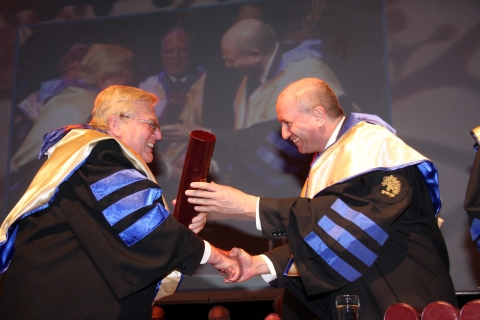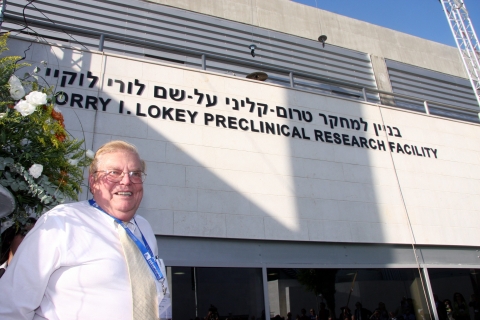Lorry Lokey
People behind the science

For this California philanthropist, Israeli science is an obvious beneficiary for his lofty goal of giving away 99 percent of his wealth.
When he was 12 years old, Lorry Lokey was asked to pick a topic to research and write about as a student in Congregation Beth Israel’s Sunday school in Portland, Oregon.He chose Dr. Chaim Weizmann. The year was 1939 - well before the founding of the State of Israel, Dr. Weizmann’s term as Israel’s first President, and the establishment of the Weizmann Institute of Science.
“I chose Chaim Weizmann because of his invention of acetone and what that did for World War I,” recalls Lokey, referring to acetone’s use in explosives which were mass-produced by Britain in the war effort against Germany. Dr. Weizmann’s invention won him favor in the eyes of the British government, which gave him access to senior cabinet members and British Foreign Secretary Arthur Balfour, and he worked with Balfour to issue the Balfour Declaration of 1917 in support of the creation of a Jewish state in Palestine.
It was Dr. Weizmann’s invention of the fermentation process and subsequently acetone that primarily intrigued the young Lokey, and he spent hours at the local library researching the topic. Additionally, he says, “I was impressed by the fact that he asked for something for a group of people and not for himself.”
Lokey, who is 87, went on to build a thriving business that enabled him to become the philanthropist he is today - with a stated goal of giving away $1 billion in his lifetime. He’s pretty close, at $740 million to date. Throughout the years, his admiration for Dr. Chaim Weizmann remained with him, and his keen sense of the value of science and technology grew in proportion to his snowballing business success. And out of that, his connection with the Weizmann Institute of Science took root and has grown. He has given generously to the Institute, most notably for the establishment of the Lorry I. Lokey Research School for Biochemical Science in 2007, and the Lorry I. Lokey Preclinical Research Facility in 2011. The Institute awarded him a PhD honoris causa in 2008.
Education and technology
Lorry Lokey grew up in Portland during the Great Depression years, where he remembers what were called “hobo jungles” - Depression-era lingo for encampments of homeless, penniless Americans. He recalls men selling apples for a nickel each, and pencils and shoelaces for pennies. “My parents barely made it through the Depression,” he recalls. “Their bank closed and they lost all their savings - all of $150. They barely held onto their house.” Luckily, his father continued to hold down a job, first as a flour salesman, then a canned foods salesman at Del Monte Foods, Inc., while also working in a shipyard. His father’s ability to hold down not just one but two jobs during the Depression forever stuck with Lorry who took pride in it and was inspired to work hard throughout his life. In his first days as a student at Stanford University in Palo Alto, Lokey picked up a copy of the Stanford Daily News, and promptly fell in love with journalism. He started at “the very bottom” at the paper, he says, later working his way up to editor-in-chief in his senior year. After his freshman year, at age 18, he was drafted into the army to serve in WWII. Stationed in Tokyo, he was assigned to be the feature editor of the Pacific edition of the U.S. military newspaper Stars & Stripes. He returned to Stanford and graduated in 1949.
His first job out of college was for United Press, the news wire service that later became United Press International (UPI). He later moved into public relations. When working for General Electric Corp. in San Francisco, he attended a conference in Los Angeles at which he saw a teletype machine; he was surprised and intrigued to see one at a PR event, where it was being used to transfer financial news. In 1961, he started Business Wire to serve companies wishing to publicize their press releases, on the one hand, and news organizations on the other, eager to receive and report on company news.
The network he had built at GE gave him his first seven clients, and they were big ones: GE, Bank of America, Standard Oil, and American Airlines were among them. On his first day on the job, he processed seven news releases. That didn’t generate him a paycheck. But four months in, with 20 clients, he had his first payday with a check for $800. For years, he personally reviewed every release that went out. Fast forward three decades: In the years before he sold Business Wire to Warren Buffet’s Berkshire Hathaway in 2006 for close to $500 million, the company had 28 offices around the world and he was earning $2 million a month. Today, hundreds of releases go out in a single minute. In running Business Wire, he says, “I was, of course, very aware of the importance of continually advancing technology, so that news could move faster,” he says. The company’s edge, he says, was its ability to identify the latest technology and leverage it to get releases out faster and faster.
The story of scientific development excites him. Living most of his life in Silicon Valley - he resides in Menlo Park, California - he says he had a “front-row seat” to some of the most thrilling scientific developments. “By the 1980s, science began moving forward very fast and especially so in Israel, because Israel had a ‘little’ matter to deal with called ‘survival’,” he says, adding, “Israel has accomplished so much in science and technology and a lot of it is because of Weizmann and the Technion. If you would subtract Weizmann from the Israeli scientific scene could you imagine what you would not have in this world?” It was this “real love,” he says, for education and research that led him to the Weizmann Institute. he says. In May, he and his partner of 23 years, Joanne Harrington, visited the Institute and brought with them three professors from the University of Oregon, with the aim of initiating scientific collaborations.
Early lessons
If one theme in his life was the value of scientific development, another was the value of philanthropy, which was instilled in him at a young age. His parents consistently gave away about five percent of their annual income of $2,200. “When my mother wrote a check for $100 to the United Jewish Appeal in the Depression years - which was a lot of money then - I challenged her on it, worried that we couldn’t afford it, and she said it was her duty and she wanted to make the contribution.”
He has passed on the value of philanthropy to his children, mainly through example, he says. Lorry has three daughters, seven grandchildren, and seven great grandchildren; and Joanne has four children and four grandchildren.
For the last 65 years, he has given away 98 percent of his earnings. Several years ago, Warren Buffett approached him to join the Giving Pledge, a commitment by the world’s wealthiest individuals to give away more than half of their wealth to philanthropy during their lifetimes or in their wills. Lokey - who says he spends modestly and typically flies coach - joined immediately. “My ambition is to see my giving get to $1 billion,” he says. “It will be very satisfying to see this happen.”
Beyond Lokey’s relationship with the Weizmann Institute, he has given widely, mainly to education. He still gives to his elementary school, and supports the Technion, the Leo Baeck School in Haifa, Ben-Gurion University, Tel Aviv University, and Hadassah Medical Center. He has given to his favorite U.S. institutions, including Stanford and its School of Medicine, the University of Oregon, Mills College, and Portland State University. He serves as a trustee on the board of Bellarmine College Preparatory and the San Francisco Opera Association. He is an emeritus trustee at Santa Clara University, the University of Oregon Foundation, and Mills College.
In making his first gift to Weizmann, for the Lorry I. Lokey Research School of Biochemical Science, he says, “I wanted to make a difference in educating the next generation of Israeli scientists.” On its heels came the establishment of the Lorry I. Lokey Preclinical Research Facility. It is the largest core research facility on the Institute’s campus and unique in the variety and sophistication of its imaging capabilities. Research conducted in the building spans the medical spectrum and includes studies on cancer, genetic disorders, neurodegenerative diseases, diabetes, bone and muscle development, and immune system disorders. It will be a key component of the Weizmann Institute’s new flagship project, the Integrated Cancer Center.
In making the gift for the facility, he called the donation “one of the best investments of my life.” He says he hopes to make another major gift to the Weizmann Institute for a second building adjacent to the Lokey Preclinical Facility.

Lorry Lokey receiving his PhD honoris causa from Prof. Daniel Zajfman in 2008.

At the dedication of the Lorry I. Lokey Preclinical Research Facility







